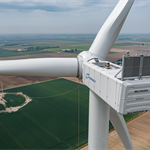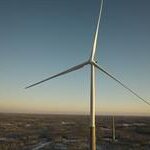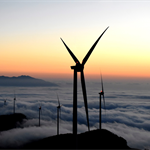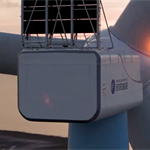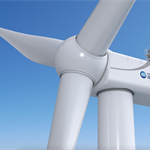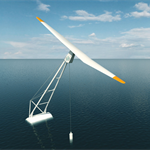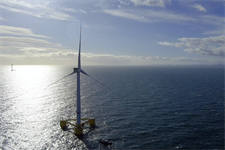Exclusive: 6MW turbine with 175m rotor unveiled as Enercon targets ‘new onshore wind top segment’
Energy Disrupter
With its enhanced 6.0MW E-175 EP5 turbine for low-wind, propelling rotor size to 175m, German direct drive pioneer Enercon has again expanded its main volume range, which already includes the 4.2MW E-138 EP3 E2/E3 and 5.56MW E-160 EP5 E3. The latest model is being unveiled to customers at WindEnergy Hamburg 2022.
Enercon’s strategy is to offer at least one competitive model in every turbine size-segment, says the company’s chief executive officer, Jürgen Zeschky. “As part of the on-going turnaround programme, our engineers have been working systematically to close current gaps,” he says. “We will now try to take a share of the new onshore wind top segment with rotor sizes above 170m with E-175 EP5.”
He adds: “Our final objective is to offer our global customer base a powerful reliable product portfolio optimally suited and continuously adapted to meet their latest requirements.”
Successful outcome
Enercon’s EP3 series was the first successful outcome of a major six-year technology transition process that started in 2016 and has since seen cumulative orders – covering all EP3 model variants – reach over 1025 turbines.
With rotor swept area nearly 60% greater than the E-138 EP3 turbine, the E-175 EP5 takes Enercon’s ongoing technology transition process to a new level. The new flagship will be certified for IEC S – a ‘user defined’ IEC class outside the common IEC I-IV classes – and a 25-year design life. At comparable 7.5m/s reference sites, it can generate at least 18% more energy a year compared to the 5.56MW E-160 EP5 certified for IEC IIIA locations, says Enercon.
The large E-175 rotor is currently one of the wind industry’s largest announced onshore sizes outside China and, combined with its 6.0MW rating, offers 249W/m2 specific power. This compares to 277W/m2 for the E160 EP5 E3.
The main development drivers were lowering levelised cost of energy (LCOE) through capital expenditure (CAPEX) ‘cost-out’ in parallel with a substantial annual energy production (AEP) increase “via the bigger rotor plus extra yield gain thanks to the 500kW uprate compared to E-160 EP5 E3”, says Enercon chief technology officer Jörg Scholle.
“The turbine is destined for global Enercon markets and purposely launched as an expansion of our proven EP5 platform instead of a brand new platform,” Scholle continues. “The main contributing reasons are that E-175 EP5 retains the generator design layout of all three E-160 EP5 model versions, plus the E-nacelle layout incorporating up-tower power electronics as introduced with E-160 EP5 E3.”
Fast ramp-up
Installation of an E-175 EP5 prototype is envisaged within the next 15 months, he adds, followed by market launch and series ramp-up in early 2024. This short time-to-market timeline is possible because E-175 EP5 builds on Enercon’s mature EP5 series platform technology – the latest E-160 EP5 E3 is the main technology carrier, with a substantial international project pipeline.
“The latest 86-metre blade development fits into Enercon’s decade-long in-house blade design tradition, and like many earlier developments, including for EP3, benefits from our comprehensive blades know-how and experience which is now all fed-in here,” says Scholle. “The [E-175 EP5] rotor blade will, in contrast to the externally developed and externally sourced E-160 blade, be launched and produced in Enercon’s blade facility in Portugal, which boasts sufficient spare capacity for the additional ramp-up.”
This is Enercon’s longest blade concept to date but Scholle is mindful to note that the maximum possible onshore rotor diameter might now have been reached, largely due to road transportation-logistics and installation requirement constraints. With many years of Enercon’s transport-logistics, handling and installation expertise, he is, however, in no doubt that an 86m blade will meet all requirements up to construction sites.
Enercon’s business strategy includes using European supply chains for all main components, except perhaps the towers. This includes E-175 EP5 generator manufacture at Enercon’s production facilities in Europe. Combined E-175 EP5 and E-160 EP5 E3 E-nacelle and hub production can also be performed at the same assembly lines in the company’s Aurich-based mechatronics facilities.
Moreover, as there are many similarities between the EP5 top models, ramp-up can be much faster too. “The new turbine shares a largely similar inner-rotor permanent magnet generator (PMG) assembled in one piece, originating from the EP5 platform,” explains Scholle. “This standardised layout, with ‘below’ 6m outer diameter, could been retained up until the 6.0MW E-175 EP5, with a key benefit being avoiding generator outer dimension becoming a main road transportation-logistical obstacle.”

Engineering challenges
A similar engineering challenge proved to be that when either rotor diameter and/or turbine rating increases, generator torque goes up in parallel. An inevitable consequence is that additional internal heat is generated which must then be dissipated. The original air-cooled generator is a mainly passive air-cooled design, which operates without internal circulation pumps and/or fans – it is characterised by favourable operating temperatures through substantial built-in thermal reserves.
Scholle explains that Enercon could retain this novel technology principle during all EP5 subsequent scaling steps by gradually reusing available thermal reserves up until E-175 EP5. Equally key during the design process, he adds, was to ensure there was no compromise when it came to ensuring and maintaining sound internal thermal, mechanical and electrical operating conditions.
“With each new scaling, we increased torque density (Nm/kg) and power density (W/kg) in parallel while retaining original generator mass and main dimensions,” Scholle says. “This incremental optimisation strategy allows safe ramp-up while taking our next industrialisation steps regarding cost-effective generator manufacture with stable process control, and building track record experience simultaneously.”
He further hints, without going into further details, that the company is continuing R&D efforts into new PMG solutions, focused on enabling higher future ratings in parallel to reducing generator CAPEX. Specific focus areas here are to bring down magnet costs while simultaneously addressing potential transport-logistical challenges for new higher rated generators.
The modular E-nacelle concept introduced with E-160 EP5 E3 was reintroduced for E-138 EP3 E2 (see box) and is now again being reapplied for the most powerful E-175 EP5. The ‘second-generation’ E-nacelles, with unchanged outer and inner dimensions, feature a new electrical system with several new visions and ideas introduced. Such new concepts include higher levels of component and systems optimisation, standardisation and modularisation, and more synergies at components level, like different numbers of similar pitch motors depending on turbine model.
“The higher E-175 EP5 rating with unchanged internal space required increasing the power and/or torque densities of the main electric and power-electronics components too, especially the MV-transformer and frequency converter modules.,” Scholle says. “The turbine controller is also new and simultaneously introduced in all EP3 and EP5 model variants. Finally, Enercon conducted a stringent E-nacelle ‘optimisation’ parallel effort, but all this was done in a careful step-by-step approach because supply chain security is key.”
Tower options
The E-175 EP5 will be available with different tower options. This includes a Max Bögl concrete-steel hybrid tower with 163m hub height, a tubular steel tower with 113m hub height, and an in-house Hybrid Steel Tower (HST) tower in 133m.
Additional hub heights, depending on specific market demands, may also be available, although in his view, Scholle says, very high towers – with the exception of a few specific circumstances ¬– can prove difficult for realising economically sound returns.
After what he describes as a challenging technology transition period for Enercon, Scholle says many projects have now been completed, with several key technologies successfully in place. “There are, no-doubt, many challenges left and new steps waiting to be taken in future,” he says. “The global wind market is thereby highly competitive with many competitors also optimising the LCOE-performance of their product offerings continuously.”
He concludes: “A main message for us at Enercon remains that we must never stop innovating or optimising and [must] continue reinventing ourselves at all levels, technology-advancement based and organisational alike.”
Update on the E-138 EP3 E3 and E-160 EP5 E3
With almost 500 units operating across at least 13 different markets, the 4.2MW E-138 EP3 E2 represents a strong pillar for Enercon’s expanding main products portfolio. The E-138 EP3 E2 is complemented by the E-115 EP3 E3, which is targeted at specific market opportunities such as repowering sites with hub height and/or tip height restrictions.
Enercon will shortly complete installation of its latest 4.26MW E-138 EP3 E3 prototype with E-nacelle in Staphorst, North of Zwolle in The Netherlands. Two more prototypes will be added to complete this project – these units are currently in the factory pre-commissioning phase, while another unit has been bench tested and validated in Enercon’s R&D test facility in Aurich.
The 4.2MW E-138 E2 predecessor model variant for IEC IIIA was first installed in 2020, succeeding the initial 3.5MW E138 E1 (with 2019 prototype).

Enercon’s E-138 EP3 E3 prototype ready for shipment
E-160 EP5 E3 – the current flagship
By mid-September, Enercon had produced over 40 E-160 EP5 E3 turbines, with the pace gradually stepping up since early this year, with four turbines now produced each week. Orders for current flagship units span several large international projects, including the 778MW Horizonte 140-turbine wind farm in Chile, now under construction.
Image credits: Enercon


